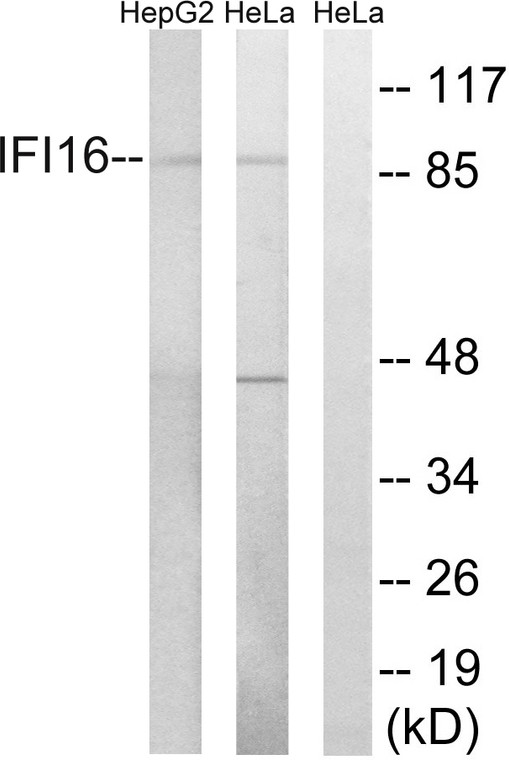| Host: |
Rabbit |
| Applications: |
WB/ELISA |
| Reactivity: |
Human/Rat/Mouse |
| Note: |
STRICTLY FOR FURTHER SCIENTIFIC RESEARCH USE ONLY (RUO). MUST NOT TO BE USED IN DIAGNOSTIC OR THERAPEUTIC APPLICATIONS. |
| Short Description: |
Rabbit polyclonal antibody anti-Gamma-interferon-inducible protein 16 (731-780 aa) is suitable for use in Western Blot and ELISA research applications. |
| Clonality: |
Polyclonal |
| Conjugation: |
Unconjugated |
| Isotype: |
IgG |
| Formulation: |
Liquid in PBS containing 50% Glycerol, 0.5% BSA and 0.02% Sodium Azide. |
| Purification: |
The antibody was affinity-purified from rabbit antiserum by affinity-chromatography using epitope-specific immunogen. |
| Concentration: |
1 mg/mL |
| Dilution Range: |
WB 1:500-1:2000ELISA 1:40000 |
| Storage Instruction: |
Store at-20°C for up to 1 year from the date of receipt, and avoid repeat freeze-thaw cycles. |
| Gene Symbol: |
IFI16 |
| Gene ID: |
3428 |
| Uniprot ID: |
IF16_HUMAN |
| Immunogen Region: |
731-780 aa |
| Specificity: |
IFI-16 Polyclonal Antibody detects endogenous levels of IFI-16 protein. |
| Immunogen: |
The antiserum was produced against synthesized peptide derived from the human IFI16 at the amino acid range 731-780 |
| Post Translational Modifications | Ubiquitinated by human herpes simplex virus 1 (HHV-1) ICP0 protein.leading to degradation by the proteasome. Lysine acetylation in the multipartite nuclear localization signal (NLS) regulates the subcellular location. In vitro can be acetylated by p300/EP300 coupled to cytoplasmic localization. Phosphorylated on Ser and Thr. Isoform 3 seems to show a minor degree of complex carbohydrate addition. |
| Function | Binds double-stranded DNA. Binds preferentially to supercoiled DNA and cruciform DNA structures. Seems to be involved in transcriptional regulation. May function as a transcriptional repressor. Could have a role in the regulation of hematopoietic differentiation through activation of unknown target genes. Controls cellular proliferation by modulating the functions of cell cycle regulatory factors including p53/TP53 and the retinoblastoma protein. May be involved in TP53-mediated transcriptional activation by enhancing TP53 sequence-specific DNA binding and modulating TP53 phosphorylation status. Seems to be involved in energy-level-dependent activation of the ATM/ AMPK/TP53 pathway coupled to regulation of autophagy. May be involved in regulation of TP53-mediated cell death also involving BRCA1. May be involved in the senescence of prostate epithelial cells. Involved in innate immune response by recognizing viral dsDNA in the cytosol and probably in the nucleus. After binding to viral DNA in the cytoplasm recruits TMEM173/STING and mediates the induction of IFN-beta. Has anti-inflammatory activity and inhibits the activation of the AIM2 inflammasome, probably via association with AIM2. Proposed to bind viral DNA in the nucleus, such as of Kaposi's sarcoma-associated herpesvirus, and to induce the formation of nuclear caspase-1-activating inflammasome formation via association with PYCARD. Inhibits replication of herpesviruses such as human cytomegalovirus (HCMV) probably by interfering with promoter recruitment of members of the Sp1 family of transcription factors. Necessary to activate the IRF3 signaling cascade during human herpes simplex virus 1 (HHV-1) infection and promotes the assembly of heterochromatin on herpesviral DNA and inhibition of viral immediate-early gene expression and replication. Involved in the MTA1-mediated epigenetic regulation of ESR1 expression in breast cancer. Isoform IFI16-beta: Isoform that specifically inhibits the AIM2 inflammasome. Binds double-stranded DNA (dsDNA) in the cytoplasm, impeding its detection by AIM2. Also prevents the interaction between AIM2 and PYCARD/ASC via its interaction with AIM2, thereby inhibiting assembly of the AIM2 inflammasome. This isoform also weakly induce production of type I interferon-beta (IFNB1) via its interaction with STING1. |
| Protein Name | Gamma-Interferon-Inducible Protein 16Ifi-16Interferon-Inducible Myeloid Differentiation Transcriptional Activator |
| Database Links | Reactome: R-HSA-1834941Reactome: R-HSA-3270619 |
| Cellular Localisation | NucleusCytoplasmCellular Distribution Is Dependent On The Acetylation Status Of The Multipartite Nuclear Localization Signal (Nls)Nls Acetylation Promotes Cytoplasmic LocalizationLocalizes In The Nucleus During Human Herpes Simplex Virus 1 (Hhv-1) InfectionIsoform Ifi16-Beta: Cytoplasm |
| Alternative Antibody Names | Anti-Gamma-Interferon-Inducible Protein 16 antibodyAnti-Ifi-16 antibodyAnti-Interferon-Inducible Myeloid Differentiation Transcriptional Activator antibodyAnti-IFI16 antibodyAnti-IFNGIP1 antibody |
Information sourced from Uniprot.org
12 months for antibodies. 6 months for ELISA Kits. Please see website T&Cs for further guidance








